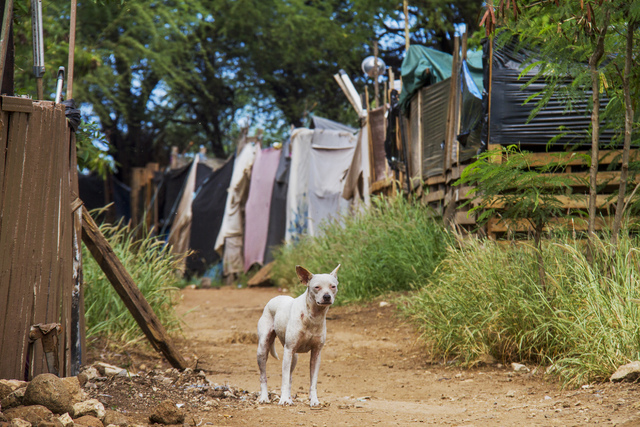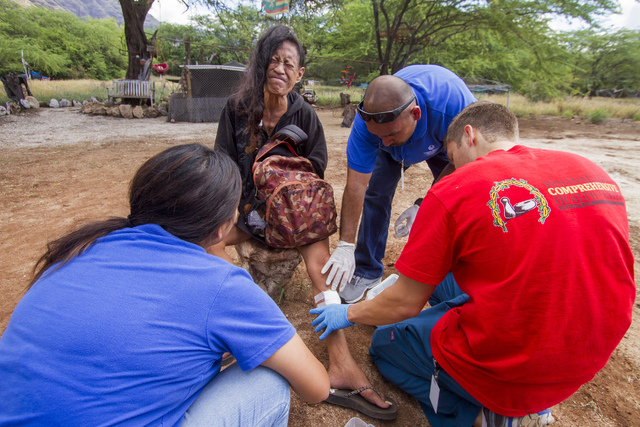A hui of outreach workers reach out to the homeless living in Waianae

DENNIS ODA / DODA@STARADVERTISER.COM
Above, a dog followed one of the many paths that crisscross through the makeshift homes of the encampment.

DENNIS ODA / DODA@STARADVERTISER.COM
At top, Kiki Dolfo winced in pain as she had her injured leg looked after and bandaged by Hawaii Pacific University nursing student Ashley Aquino, left, Taylor Dietz of Waianae Coast Comprehensive Health Center (in red) and HPU nursing student Rogelio Balthazar.

DENNIS ODA / DODA@STARADVERTISER.COM
About a dozen government and social service agencies set up informational tents in the park next to the homeless encampment, to inform the residents about the help they can get. Dan Estauillo, 53, and his girlfriend, Lean Kalua, 45, at the entrance to their makeshift home in the encampment.



For the first time, a hui of 17 nonprofit groups and state and federal agencies reached out to the 289 occupants of an entrenched homeless encampment at the mouth of the Waianae Small Boat Harbor on Friday to offer an array of services, but getting people to give up their ocean-side life off the grid remained a challenge.
Twinkle Borge, who is often called the unofficial mayor of the encampment, welcomed the unprecedented outreach and expressed hope that her homeless neighbors are able to get their birth certificates, government identifications, Social Security benefits and other assistance that could make life easier for them and, perhaps, lead them to seek permanent housing.
Borge looked out across a ring of canopies staffed by social service workers and agencies on the lawn that separates the encampment from nearby tennis courts and said, “It’s like one positive hug for the people.”
But like others, Borge has little intention of leaving the place she calls “Pu‘uhonua,” or place of refuge.
It’s where she’s lived for the last 13 years, and where she got sober 10 years ago.
“Some people are set in their ways,” Borge said. “For me, this is my home.”
Don't miss out on what's happening!
Stay in touch with breaking news, as it happens, conveniently in your email inbox. It's FREE!
A family of six, a couple and one other person agreed to move out of the encampment and into a shelter, according to the state homeless coordinator’s office, which organized the outreach.
In all, an estimated 150 people attended the four-hour event. People seeking services tended to visit more than one organization and collectively they added up to a total of 467 contacts.
A group of University of Hawaii and Hawaii Pacific University student nurses provided first aid while other homeless people lined up to learn about getting help with security deposits and first and last months’ rent that could lead to a traditional home.
A community encampment
Scott Morishige, the state’s homeless coordinator, said many of the homeless have been living in the encampment for a decade or more and he estimated that the majority grew up along the Waianae Coast.
While some suffer from mental illness and drug addiction, many others have jobs and simply lack enough money to afford a place to live, Morishige said.
The size of Pu‘uhonua rivals the notorious urban homeless encampment in Kakaako that at one point last year swelled to a population of more than 300 adults and children before it was cleaned out and reduced to a tenth of its size.
Borge said that in the last head count, the Waianae encampment of 289 people tucked among the brush included 48 children and 147 dogs.
At Pu‘uhonua, signs are posted reminding people to clean up after themselves and the occupants kick people out for stealing and other bad behavior.
Even some recent newcomers to the encampment, who asked not to be identified Friday, said they were welcomed in, given plywood and pallets to organize their living spaces and told they were expected to reciprocate by keeping their areas clean and respecting others.
Some City Council members have cited the encampment’s rules and sense of community as a model that could be emulated if the city decides to create its own city-sanctioned tent cities somewhere on Oahu, as mainland cities such as Seattle have done.
On Friday, clothes hung on lines outside the tents where Lean Kalua, 45, and Dan Estauillo, 53, have lived with their dog, Mana, for the last two years.
Estauillo, who was getting ready for work as a roofer, had turned pallets into a sturdy lanai below the couple’s tents.
Despite the relative cleanliness of the encampment, Estauillo said that life in Pu‘uhonua “is hard living.”
He has his identification and a job and didn’t really need most of the services being offered near the tennis courts.
Asked what he needs most of all, Estauillo said bluntly, “Housing.”
The land under the encampment belongs to the state Department of Land and Natural Resources’ Division of Aquatic Resources and officials worry about ancient rock terraces that have disappeared; the possibility that ancient human remains — or iwi — are buried on the property; and potential harm being caused to subterranean opae ulua, or Hawaiian red shrimp, that are found only in Waianae and live in anchialine pools.
“Ultimately it’s public land being used for personal purposes,” said DLNR spokesman Dan Dennison, who attended Friday’s outreach.
Maria Vuong, community clearing house supervisor for Helping Hands Hawaii, walked through the sprawling encampment with representatives from other agencies and invited people to check out the services being offered.
It was Vuong’s first visit to the encampment and she said she was impressed by the sophistication of the structures and the air of camaraderie and order.
“They have a sense of community,” Vuong said. “It’s very clear they respect each other.”
Gregrey Kim, homeless outreach interim case manager for Waianae-based Hale Na‘au Pono — a nonprofit mental health center — has worked with clients from the encampment before and knows how difficult it is for the occupants to leave.
“When it’s as good as this,” Kim said, “they really like no move out. That’s why it’s hard to get them housing.”
14 responses to “A hui of outreach workers reach out to the homeless living in Waianae”
Leave a Reply
You must be logged in to post a comment.




Ha Ha Ha “outreach”. Ridiculous effort. They like their free oceanfront living quarters which the City allows them to occupy against all laws. This livestyle will grow like a cancer.
I understand where you’re coming from and share your frustration. But what are the options for right now? For the short term? For the long haul? This encampment on public property is not the long-term answer, but it may be an answer for right now and the near future. There are apparently many like Dan Estauillo who have jobs but just can’t afford housing. We gotta respect them and “reach out” to honor their effort. There’s something fundamentally wrong with a society in which a working person cannot afford to put a roof over his head. Outreach as a handout is useless, but outreach as a hand up is worthwhile. Mahalo, Dan Nakaso, for an informative story and a useful takeaway: “Some City Council members have cited the encampment’s rules and sense of community as a model that could be emulated if the city decides to create its own city-sanctioned tent cities somewhere on Oahu, as mainland cities such as Seattle have done.”
What’s wrong with society? Desastrous overpopulation exacerbated by rampant immigration, that is wrong with society and ruins everything!
What we should do:
1. stop all immigration.
2. make it illegal to produce more than 2 children per couple.
3. make it illegal for homeless to produce any children.
4. force all homeless into orderly camps like the World War 2 camps
5. tear down any illegal encampment the moment it starts – not wait until there are hundreds.
If we don’t do this in time we will have lawless Favelas all over the Islands with ten thousands of hoodlums like in Brazil.
As a practical matter, many of these homeless “clean up” efforts just make things worse. Several years ago the Navy and the City decided to “clean up” the homeless living in the mangroves along Pearl Harbor in Aiea and Pearl City. They destroyed the homeless shelters and cut down the mangroves. Since then the homeless have taken up residence right along the Pearl Harbor bike path and in Neil Blaisdale Park. Now, instead of living off in the mangroves mostly out of the way and out of sight, the homeless have taken over the park shelters and bathrooms and built their shelters right between the bike path and the water, completely blocking public access from the park to the shoreline. The homeless community in Waianae is stable, peaceful and self governing. Help the people with outreach and offer assistance and access to social programs. Do not destroy a social system that is working and costing the city very little.
Thank you Mr. Dennison
They’ll stretch out their stay as long as possible, as long as they keep receiving free assistance and no enforced area sweeps. They know they won’t be going to jail, so what do they have to lose, other than a few grocery carts chock full of worthlessness?
The hell with those who steal all these grocery cards
The wretched refuse of our teeming Waianae shores.
Nothing a good brush fire wouldn’t take care of.
retire, that’s a very insensitive comment.
Some of these folks were kicking back, drinking, and using drugs before welfare reform took hold during the Clinton area. I remember it well because I was going off to work everyday while this people did not. Then the recession hit, and none of them had a clue as to how to survive because they had been sponging off the government for so long they had no skill set to offer. They want respect, but have no self respect.
What would Jesus say?
These residents must have a major problem with rodents!
I think the native rodents deserve better homes to infest than the tent cities the bums build. After all, the rodents were here before the bums dating back to the days when they got off Captain Cooks ship!